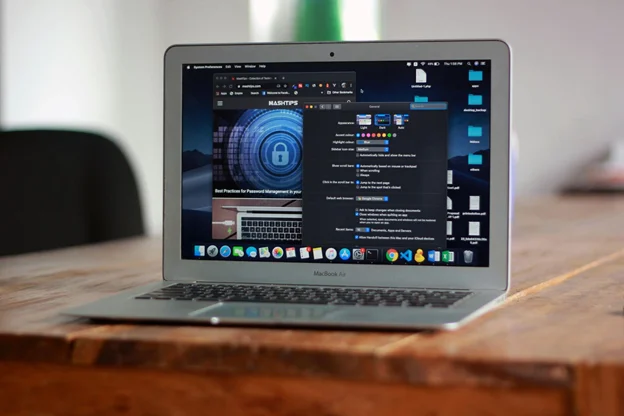macOS stands out as an effective operating system because of its many security features. These features provide advanced data protection which builds user confidence in the system. Although these features are built into the operating system, many are not automatically enabled. Every Mac user should know these MacBook settings to boost their security against malware, hackers, and all online threats. Here are important Mac security settings you should know and activate.

Turn on the Mac Firewall
Mac Firewall is your computer’s guard, protecting you from unwanted connections with other devices. These Apple menu system settings protect you from hackers, malicious software, and other harmful intruders. It is available in System Settings and activating it blocks third-party connections and allows your preferred connections. Open System Preferences – Security and Privacy – Firewall and click the icon to turn it on.
You might be wondering – does Mac need antivirus considering it has many security features? While macOS has built-in protections, vpnpro emphasizes that using a reputable antivirus for Mac adds an essential layer of security, especially for users handling sensitive information or working online frequently. Having antivirus software on your computer provides additional protection from many online and offline threats. It is important for providing virus notification on Mac, allowing users to take quick mitigation steps. It lets you scan and check for viruses on Mac system. This ensures the system is clean and data is safe. Understand the best security features you desire in an antivirus tool before downloading or installing one.
Create a screen lock and strong password
Anyone with your account password can access all your data without requiring authorization. They get an easy way to compromise your private information and system security settings. Understand Mac password requirements and ensure you follow them to the last point. A stronger password makes it harder for anyone to view or steal your data for any reason.
It should be a mix of characters like uppercase, numbers, and symbols. Make it complicated but also easy to remember to avoid changing your passwords after every login. Open System Preferences and scroll down to Users and Groups. Open your account and select Change Password to create the strongest login ever. Use a password or biometrics for your screen lock to restrict access to your Mac.
Configure Safari Settings
A secure Safari ensures your entire Mac system is safe from online intruders like hackers and malicious software. There are several Safari settings you can configure to build a strong safety wall around your browser. These include blocking pop-ups, disabling autofill, and enabling malicious website warnings. You can set up these features by opening Safari and scrolling to the Preferences button.
Open the Website button and scroll to Block your preferred pop-ups. Open Security and check the box to receive a warning when you open a fraudulent website. Open Autofill and uncheck the box to prevent autofill. This protects you from receiving phishing attacks or saving your sensitive data like credit card information online.

Create Steam privacy settings
Steam privacy settings are Mac security settings restricting access by some users while allowing access to others. It hides or reveals your gaming activities, profile details, or other online and offline activities. These settings let you set your computer to a private, public, or friends-only profile. It restricts the information they can share or view, keeping interactions with other users under control. Follow this guide to create Steam privacy settings.
● Open the Steam button and click on your profile name.
● Open View My Profile and click Edit Profile.
● Scroll down to the Privacy Settings button.
● Change the options and set it up to Private, Public, or Friends Only.
Turn on FileVault Disk Encryption
FileVault is a Mac access control tool that secures data stored in a hard drive by encrypting it. This blocks data access even in the unlikely case that you have lost your device or if somebody stole it. The tool automatically encrypts all data every time you add more information keeping it safe. To activate this feature, open System Preferences – Security and Privacy – FileVault – and turn it on. For your data to be accessible and decrypted, the system will ask you to create a password.
Manage app permissions
Your Mac applications may require various permissions to access different tools and features. Some may require permission to access your location, documents, and microphone. Some apps might be malicious and breach your data and steal it.
Review the applications or features that each application is able to access to manage these permissions, ensuring that the software adheres to code security best practices. Change the settings and restrict access to apps that you trust. To manage your app permissions, open System Preferences and scroll to Security and Privacy. Scroll down to the Privacy button and adjust the permissions.
Set up 2-factor authentication
Your Apple ID provides access to various services like iMessage, Music, and iCloud. It provides an additional access layer and lets users sync multiple Apple devices.Two-factor authentication is a safety feature that needs extra security information. Using it on your Apple ID strengthens your account security and protects your data from access by third parties. These are the steps for installing 2FA on a Mac.
● Open System Settings and scroll down to the Apple ID button.
● Open Apple ID settings and scroll to Password and Security.
● Scroll to Two-Factor Authentication and click on the box to turn it on.
● An onscreen prompt will show up as soon as you turn it on and walk you through the setup procedure. To finish the process, follow the instructions.
Enable Gatekeeper
Sometimes you may download and install malicious software unaware. Gatekeeper protects your Mac by preventing such downloads and installations from happening. It only allows the installation of apps downloaded from the App Store and Apple-authorized developers. This is important for preventing malware, phishing apps, and other viruses from infecting your Mac. To enable Gatekeeper, open the System Preferences – Security and Privacy – General tab and activate it.
Enable automatic security updates
Enabling automatic updates ensures your macOS security and applications stay updated all the time. It harnesses your computer’s performance keeping it more stable and productive. Enhancing software compatibility and lowering the danger of malware and phishing attacks are two benefits of an automatically updated Mac. It is an excellent way to boost your computer security and keep it free from vulnerabilities.
Set up advanced updates to allow your computer to install security patches immediately after download. Navigate to the Software Update button in System Preferences to activate this feature. Scroll down to Automatically update my Mac button and check it to activate the feature.
Setup password input after sleep
Your Mac may sometimes remain inactive for a while and activate sleep mode or screen saver. If you leave it unattended, Someone may wake the screen and access your data. Customize your computer so that it asks for a password to exit screen saver or sleep mode. Keeping your computer and data safe from hackers starts with taking this important step.
To do this open System Preferences – Security and Privacy – General. Go to the Require Password after sleep or screensaver button and activate it. Ensure the delay time is immediate to ensure no one gets a view of your data after sleep.
Turn on Find My Mac
There is a probability that your Mac could get stolen especially if you leave it unattended in public places or offices. Theft causes stress even when you have encrypted data and put all security measures in place.
Find My Mac is a feature that helps you locate your device’s location after a theft. It uses a macOS location app to send its precise location on the map. You can use your phone to erase all data in the computer or lock it remotely to protect your information. Open System Settings – Apple ID – iCloud – Find My Mac to activate this feature.
Conclusion
Your MacBook contains many security features built into the operating system. Although these features are important, they are not activated by default and must be activated in Mac System Settings. Stay alert and ensure your computer is safe from attacks by setting up all security features. This boosts your Mac performance providing you with an exciting user experience. Review the settings regularly to ensure they are up to date and your operating system is updated for enhanced security.
- Free Software Alternatives to Premium Design, Writing & Cybersecurity Tools - April 4, 2025
- 6 Best AI Human Resources Tools in 2025 - March 14, 2025
- Affiliate Software for SaaS Business - March 10, 2025


